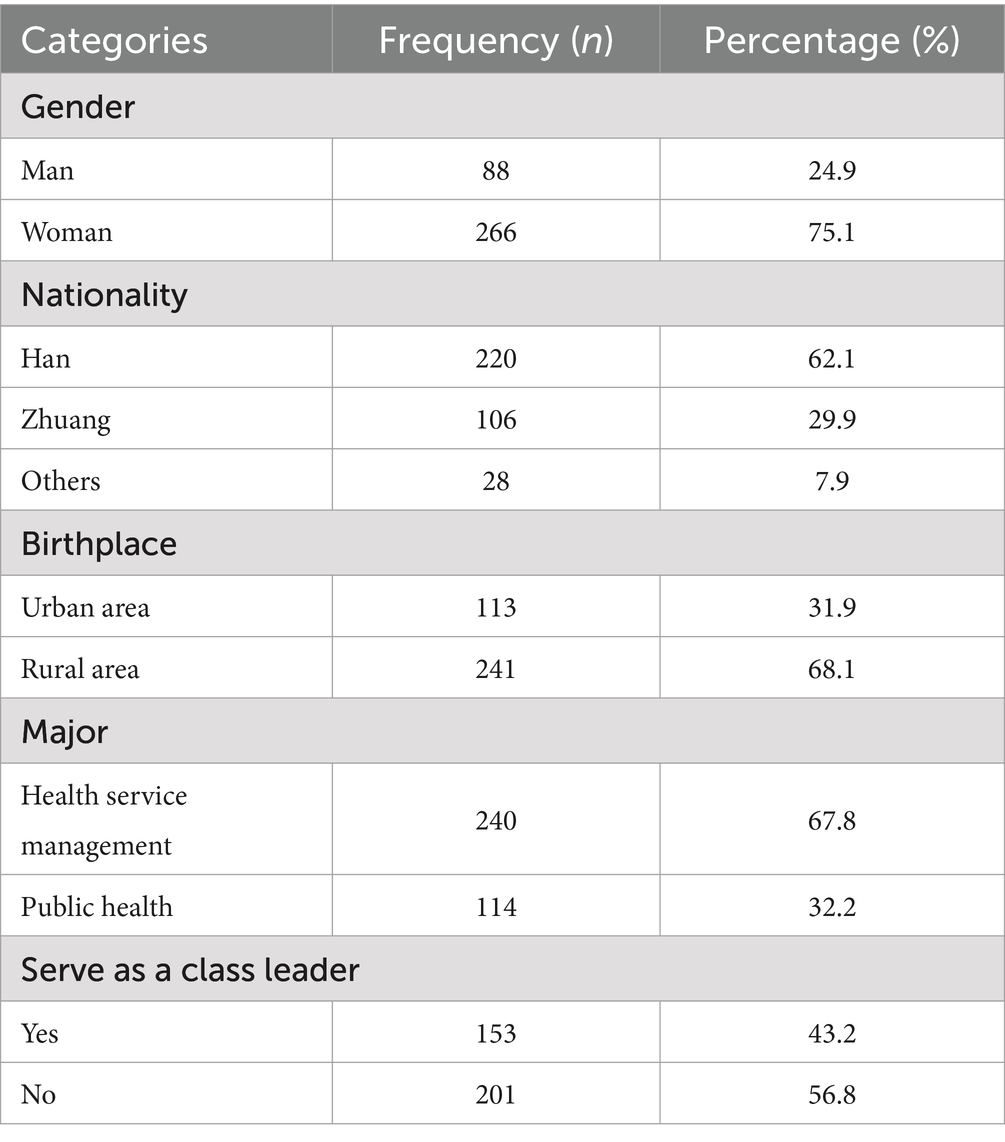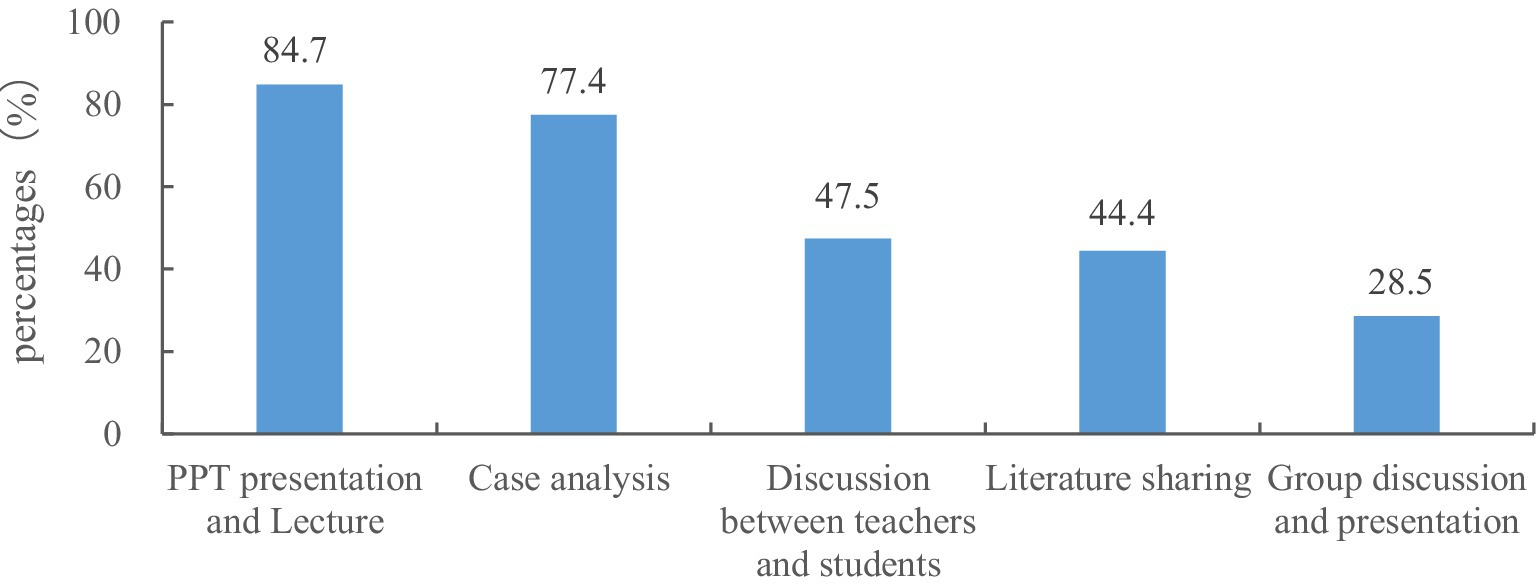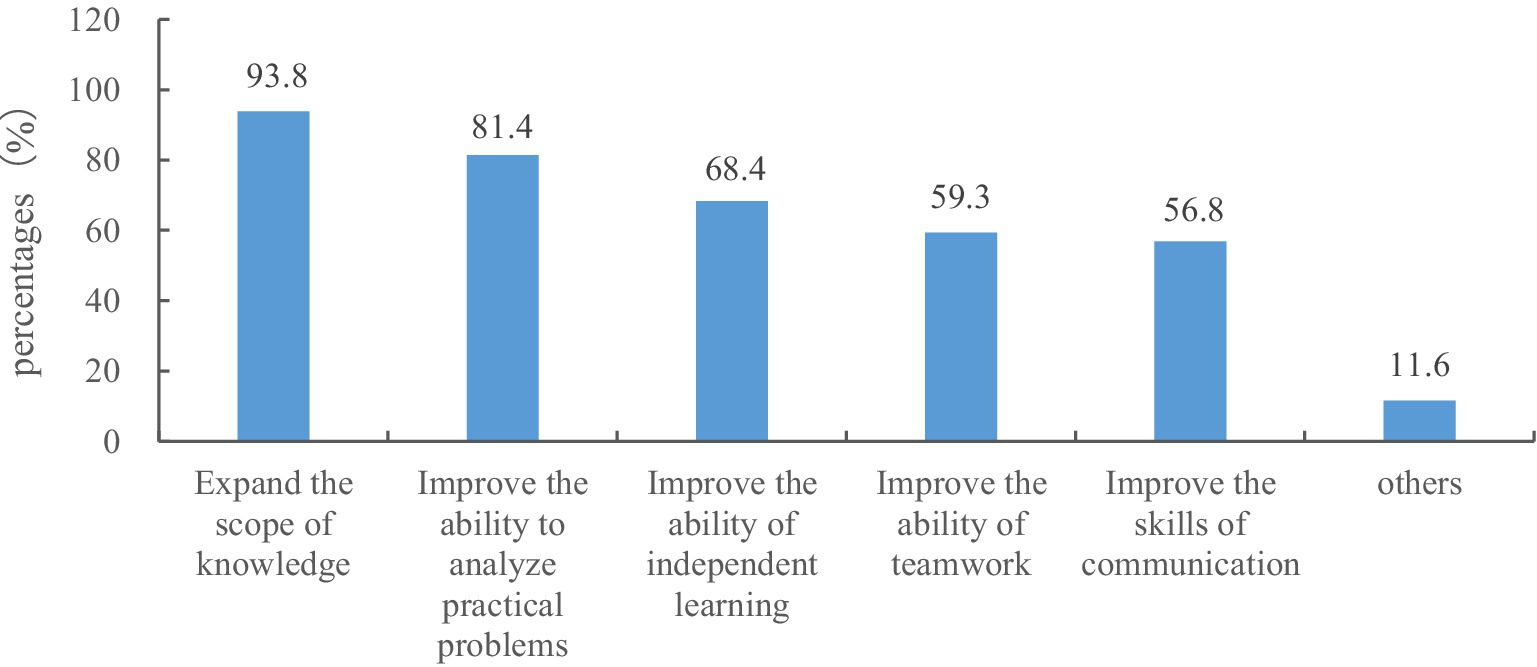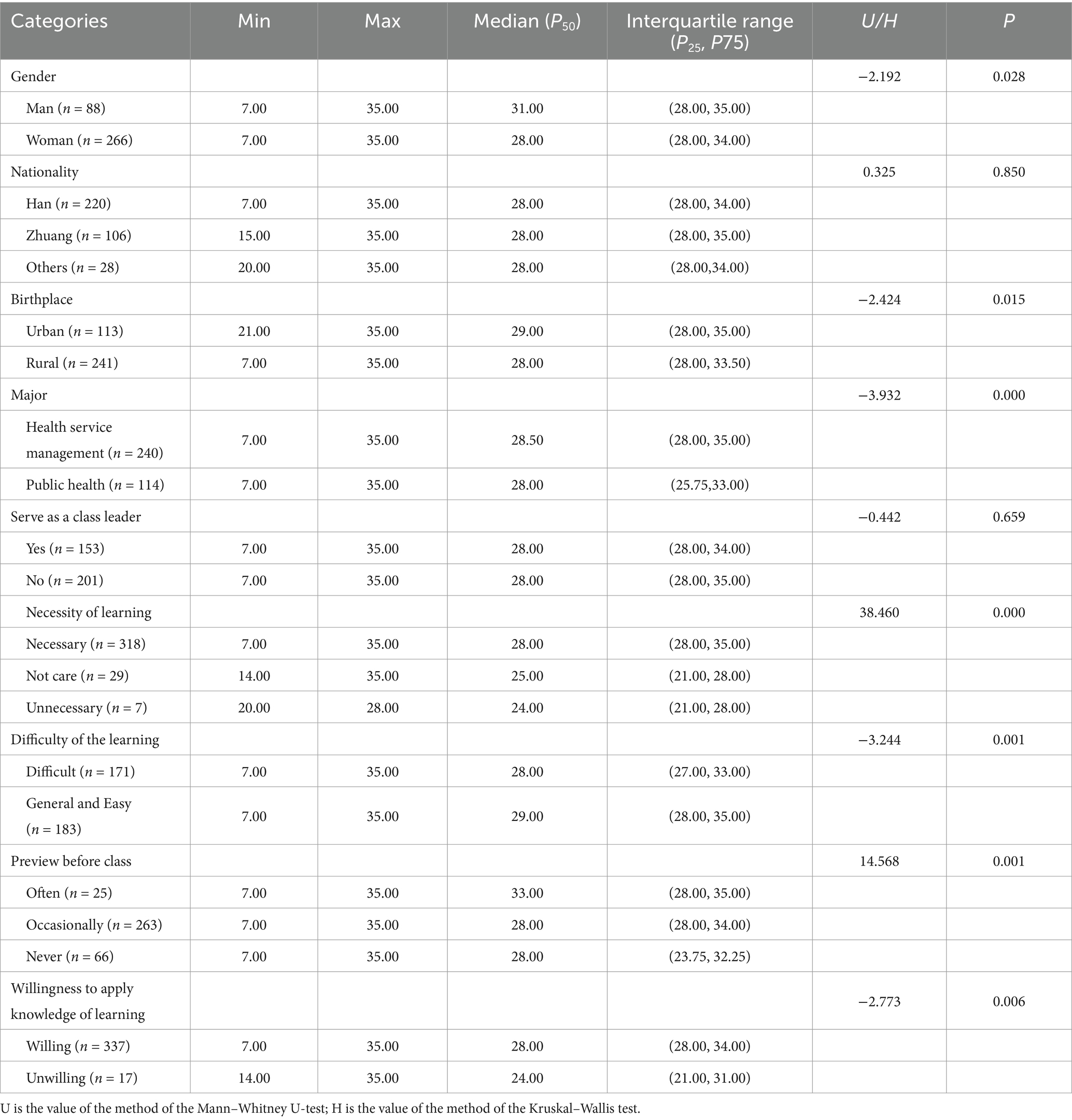- Department of Health Service Management, School of Information and Management, Guangxi Medical University, Nanning, China
Introduction: In China, the course of health economics in college is becoming increasingly important. It is very important to evaluate the learning attitude and feedback of college students in time to improve the teaching quality. However, there are few relevant studies. This study aims to understand the current situations of learning attitude and learning satisfaction about the course of health economics and its influencing factors based on the perspective of students, and put forward countermeasures and suggestions to improve the possible problems, to provide evidence-based reference for constantly improving the quality of teaching of health economics.
Methods: In this cross-sectional study, 354 students from a medical college in Guangxi were selected by the purpose sampling method, and online questionnaires were used to investigate the learning attitudes and satisfaction of college students about health economics. Descriptive and inferential statistical analyses of the collected data were carried out using IBM SPSS statistical software, with the aim of discussing how to optimize the teaching of health economics under the concept of student-centered evaluation in Chinese colleges, based on the findings.
Results: It showed that students demonstrated higher learning enthusiasm and greater learning satisfaction. Chi-square test results showed a statistically significant difference in attitudes toward the “difficulty of learning” between students of different genders (x2 = 11.987, p = 0.002) and different birthplace (x2 = 8.750, p = 0.013). There was a statistically significant difference in attitudes toward “preview before class” among students from different majors (x2 = 14.929, p = 0.001). The Wilcoxon rank-sum test showed statistically significant differences in overall satisfaction scores based on genders, birthplaces, majors, and learning attitudes (p < 0.05).
Discussion: To improve the teaching effectiveness of the course, greater attention should be given to female students, those from rural areas, and public health majors. The course should adopt a student-centered teaching design that cultivates students’ability to independent learning, thinking, and expression.
Introduction
Health economics is a branch of economics. It studies the economic phenomena and laws in the field of health services by using the theories and methods of economics. It uses economic theory to maximize the use of scarce resources, thereby improving the quality of health care and promoting evidence-based medical practice. The role of economic analysis in modern health care is becoming increasingly critical (Jain, 2022). Therefore, health economics should be included in the curriculum of medical colleges (Turner et al., 2022; Oppong et al., 2013). In China, health economics is a core course for undergraduates majoring in health service management and public health in medical colleges. It is highly theoretical, practical, and comprehensive, and primarily aims to cultivate students’ ability to analyze economic laws and problems in the field of health services by using economic theories and methods (Liang et al., 2014; Yan et al., 2022; Zhang et al., 2020). Therefore, ensuring the teaching quality of health economics is essential for achieving the above teaching objectives. Over the past 20 years, the concepts of student-centered and learning-centered evaluation have continuously led to the transformation of higher education teaching quality assessment toward a learning paradigm. These approaches have gradually become an important research focus in the evaluation of college student learning in China. To promote the connotative development of higher education, quality is the core, and evaluation is the key (Wu et al., 2022).
Currently, the predominant research methods for assessing course teaching quality encompass qualitative interviews (Smith et al., 2018), questionnaire-based surveys (Li et al., 2018; Jung et al., 2018), and mixed-method approaches (Yeh, 2022; Jacobsen et al., 2022). The research perspectives typically include students or teachers (Debroy et al., 2019; Gan et al., 2021), with evaluation based on students’ perspectives being more common. Some studies (Debroy et al., 2019; Gencoglu et al., 2021) have suggested that student evaluation of teaching is considered to be one of the most important as well as cost-effective resources for sustaining professional development in medical teaching and can be used as a tool for quality assurance in medical education. The evaluation of student learning satisfaction is a popular topic of research (Tadesse et al., 2022; Hu et al., 2022; Decavèle et al., 2022; Temesgen et al., 2021). Previous studies have identified several dimensions for evaluating student learning satisfaction, including course content, teaching methods, the teacher’s image or voice (Yuan et al., 2021), interaction during the course (Yeh, 2022), and teaching methods. Factors influencing the learning satisfaction of students included demographic characteristics (Barakzai and Fraser, 2005), learning style, learning cognition, and learning environment (Venkatesh et al., 2020). However, the learning satisfaction of students about health economics and its influencing factors has not been reported (Spura et al., 2019).
Health economics is a branch of economics that may be out of the expected medical curriculum perceived by many medical students, and it is a challenging subject for medical students. Therefore, it is essential to evaluate students’ learning behaviors and feedback. This study aims to understand the current situations of learning attitude and learning satisfaction about the course of health economics and its influencing factors based on the perspective of students, and put forward countermeasures and suggestions to improve the possible problems, to provide evidence-based reference for constantly improving the quality of teaching of health economics.
Materials and methods
Study area
This study was conducted in a medical college from 15 December 2022 to 30 December 2022. The college is located in the city of Nanning, the capital of Guangxi Zhuang Autonomous Region, China. The college has formed a complete education and training system for bachelor’s, master’s, doctoral, and post-doctoral. It currently has seven college disciplines, including medicine, management, and education. Now, the course in health economics is offered for undergraduates majoring in health service management and public health, which is taught in the fall semester of the third year of college. In 2022, there were 372 students participating in the course in health economics.
Study design
This study adopted a cross-sectional research method. An online questionnaire survey was conducted among students majoring in health service management and public health after all the courses in health economics had just ended for the semester. The purpose sampling method was adopted to select all the students participating in the course of health economics to conduct the survey. All participants signed an informed consent form.
Data collection
The data were collected through an online questionnaire, and a self-designed questionnaire according to the relevant literature and discussion by members of the research group was used. The questionnaire was initially pre-tested and validated among 20 students for feedback to ensure a consistent interpretation of the questions. This group of students was later excluded from the study. The questionnaire was distributed through the online survey platform “Questionnaire Star” in Chinese, and the responses were self-administered by the respondents.
The questionnaire was divided into four parts. The first part included questions about participants’ socio-demographic characteristics, including gender, ethnicity, birthplace, major, and whether serving as a class leader or as a cadre of a mass organization. The second part focuses on the learning attitudes and opinions about the course of health economics, including four questions about learning attitudes (there is the necessity of learning, the difficulty of learning, the preview before class, and the willingness to apply knowledge of learning) and two questions about the learning opinions (there is students’ preferences for different teaching forms about the course of health economics, the harvest after learning the course of health economic). The third part focused on the students’ learning satisfaction about the course of health economics, including seven questions about the satisfaction with the teaching content, the teaching schedule, the PPT of the course, the lectures by teachers, the appearance of teachers, the interaction in class, and the guidance in and out of class, separately.
Measurement of satisfaction
The satisfaction of students was scored using the 5-Likert scale. Five options were set for each question related to satisfaction in the questionnaire: very satisfied, satisfied, average, dissatisfied, and very dissatisfied. The corresponding scores were 5 points, 4 points, 3 points, 2 points, and 1 point, respectively.
The study measured the individual satisfaction scores and the overall satisfaction scores. The individual satisfaction scores were the scores of the corresponding option in each related question. The overall satisfaction scores were the sum of the scores of the seven options corresponding to the seven relevant questions.
Data analysis
The software Microsoft Excel was used to input data from the questionnaire, and the software IBM SPSS Statistics for Windows, Version 25.0 (Corporation, Armonk, State of New York) was used to conduct statistical analysis. Categorical data were described using rates and proportions. For continuous data that did not follow a normal distribution, median and interquartile range (IQR) were used for statistical description. The chi-square test was utilized to analyze differences in proportions between groups, while the Mann–Whitney U-test (rank-sum test) was applied to compare median differences among groups. A p-value of < 0.05 was considered significant.
Ethical approval and confidentiality
The ethical approval was provided by the Research Ethics Board of Health (REBH), Guangxi Medical University, China. In addition, administrative clearance was obtained from the college administration. All the participants signed an informed consent form before participating in this study. The survey data are stored in password-encrypted folders of the principal investigator and co-investigators.
Results
Baseline data
A total of 372 questionnaires were distributed, and 354 valid questionnaires were returned. The valid questionnaire rate was 95.2% (354/372). Table 1 shows that among 354 students, 266 were female (75.1%), 220 were of Han nationality (62.1%), 241 came from rural areas (68.1%), 240 majored in health service management (67.8%), and 201 had not served as a class leader (56.8%).
The reliability and validity analysis results of the questionnaire showed that the value of alpha was 0.967 and the value of KMO was 0.934. The results of Bartlett’s sphericity test had statistics ( = 3003.082, p = 0.000), which indicated that the questionnaire had good reliability and validity.
The learning attitudes about the course of health economics
The overall learning attitude of 354 students regarding the health economics course was as follows: About the question “How necessary to learn the course of health economics?,” 318 (89.9%), 29 (8.2%), and 7 (2.0%) students answered “necessary,” “indifferent,” and “unnecessary,” respectively. About the question “How difficult to learn the course of health economics?,” 171 (89.9%), 182 (8.2%), and 1 (2.0%) students answered “difficult,” “general,” and “easy,” respectively. About the question “how about the preview before class?,” 25 (7.1%), 263 (74.3%), and 66 (18.6%) students answered “often,” “occasionally,” and “never,” respectively. About the question “Whether willing to apply the knowledge of learning to practice?,” 337 (95.2%) and 17 (4.8%) students answered “willing” and “unwilling,” respectively.
Tables 2, 3 show the learning attitudes of students in different categories toward the course of health economics. About the question “How necessary to learn the course of health economics?,” there were no statistically significant differences in the answers of students in different categories (p > 0.05). About the question “How difficult to learn the course of health economics?,” there were statistically significant differences in the answers of students of different genders ( = 11.987, p = 0.002) and different birthplace ( = 8.750, p = 0.013). About the question “how about the preview before class?,” there were statistically significant differences in the answers of students with a different major ( = 14.929, p = 0.001). About the question “Whether willing to apply the knowledge of learning to practice?,” there were no statistically significant differences in the answers of students in different categories (p > 0.05).
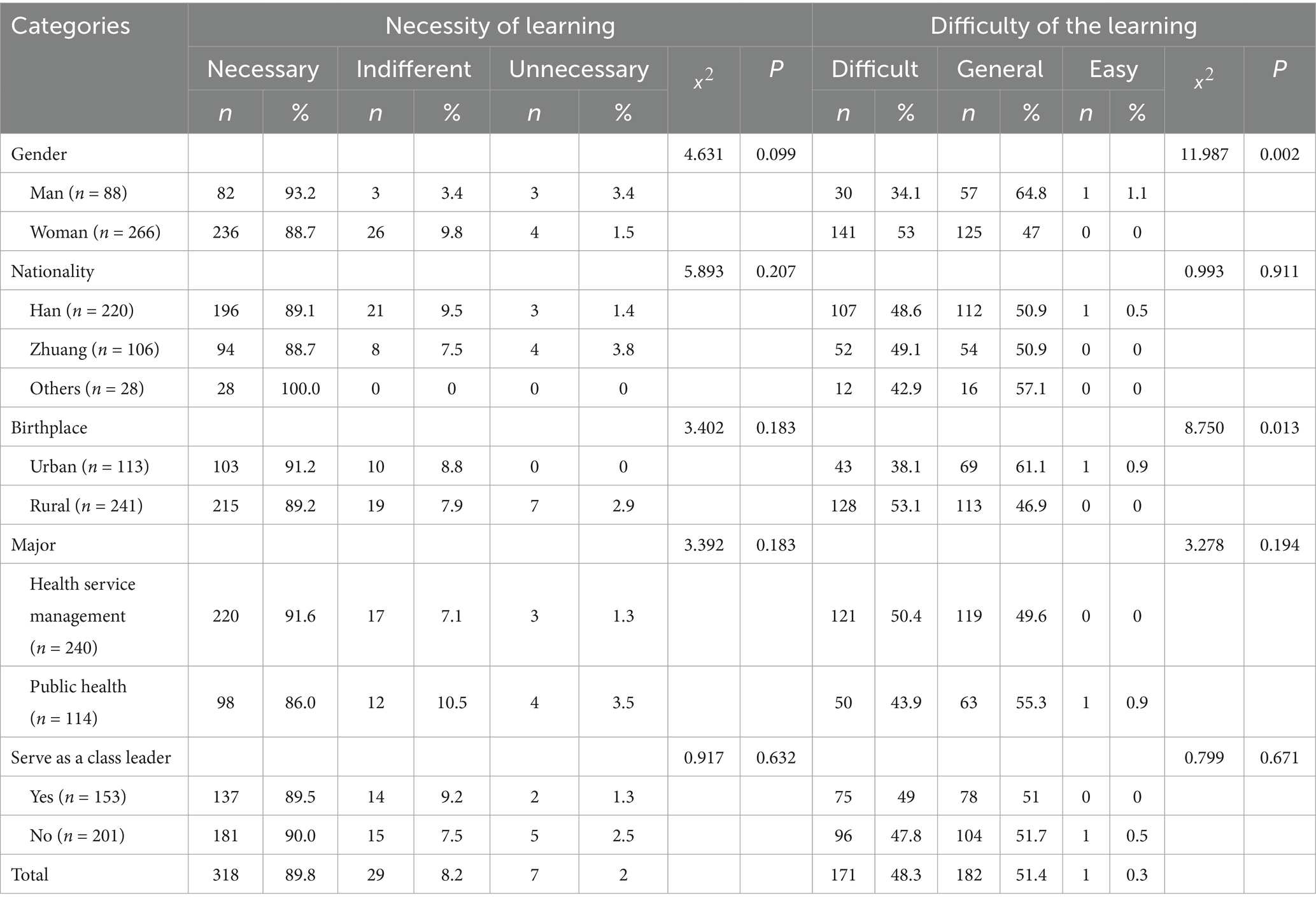
Table 2. The learning attitudes (necessity of learning and difficulty of the learning) of students in different categories (n = 354).
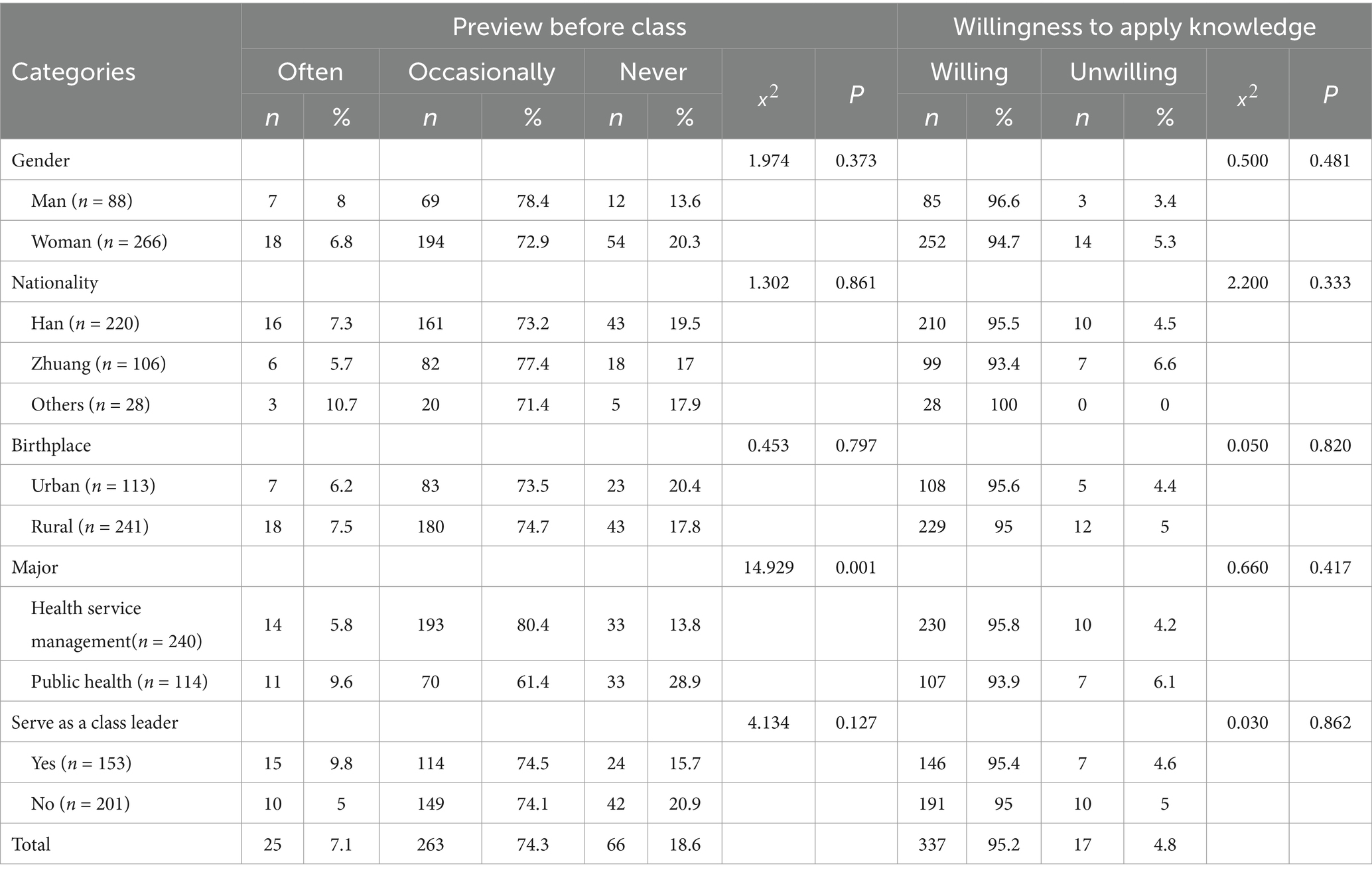
Table 3. The learning attitudes (preview before class and willingness to apply knowledge) of students in different categories (n = 354).
Figure 1 shows students’ preferences for different teaching forms of the course of health economics. In the result of all selected options, the option “PPT presentation and lecture” had the highest percentage (84.7%); the option “group discussion report” had the lowest percentage (28.5%). Figure 2 shows the harvest after learning the course of health economics. In the result of all selected options, the option “expand the scope of knowledge” had the highest percentage (93.8%); the option “others” had the lowest percentage (28.5%).
The learning satisfaction about the course of health economics
A normality test was conducted on the distribution of individual satisfaction scores and the overall satisfaction scores of students, and the results of Kolmogorov–Smirnoff showed that none of them were consistent with normality (p < 0.05). Therefore, for the satisfaction scores of students, the median (interquartile range) was used for statistical description, and the Wilcoxon rank-sum test was used for the comparison of differences between groups.
Table 4 shows that the median of individual satisfaction scores and the overall satisfaction scores of students were 4.00 and 28.00, respectively; the interquartile range of individual satisfaction scores and the overall satisfaction scores of students were (4.00, 5.00) and (28.00, 34.00), respectively. Table 5 shows that the overall satisfaction scores of students with different genders, birthplaces, majors, and learning attitudes were statistically significant (p < 0.05). Students who were male (median = 31.00), who came from urban (median = 29.00) and who majoring in health service management (median = 28.50), and who thought it was necessary to learn (median = 28.00) and thought it had average difficulty or easy to learn (median = 29.00), and who often preview before class (median = 33.00), and who had willingness to apply the knowledge of learning (median = 28.00) gained higher scores, respectively.

Table 4. The individual satisfaction scores and the overall satisfaction scores of students (N = 354).
Discussion
Health economics is the theoretical basis for analyzing the economic laws and phenomena of the health service market, indispensable knowledge for the staff engaged in health service and health service management, and an important course in the medical education system during the new era in China. The results of this study showed that most college students thought that learning health economics could expand their knowledge (93.8%) and improve their ability to analyze practical problems (81.4%), which indicated that the necessity and importance of health economics knowledge had been recognized. Therefore, in terms of learning attitude toward the course of health economics, more than 86.0% of the students thought it was necessary to learn, and more than 93.0% of the students were willing to apply what they have learned in practice. This indicated that most students had a higher cognition and demand for health economics knowledge and a higher learning enthusiasm. However, more than 98.0% of the students reported that it was difficult to learn the course of health economics, and about half of the students even thought it was very difficult. Because health economics was a comprehensive application of multi-disciplinary knowledge, including medicine, economics, statistics, and sociology. In the process of learning the course of health economics, it was necessary to use economic thinking to analyze the problems and phenomena in the health service market based on fully understanding the policy, composition, and development of the medical and health service system at home and abroad. However, students majoring in health service management and public health might face many challenges in the learning process, such as weak theoretical knowledge of economics, poor ability of mathematical statistics, and lack of social practice. Therefore, more students (84.7%) preferred to listen to the teachers and watch PPT in class and disliked participating in classroom interaction such as teacher-student discussion, group discussion, and presentation, which led to the situation that the course of health economics was both difficult to teach and difficult to learn (Liu et al., 2022).
The results of this study also showed that female students and students from rural areas reported that the course of health economics was more difficult to learn. This might be due to the fact that to learn the health economics course required more abstract, active thinking, and broader vision, which might be relatively weak in female students and students from rural areas. In addition, in terms of preview before class, more than 80% of the students had the habit of previewing, indicating that most of the students attached a high degree of importance to learning the course of health economics. However, students majoring in health service management (84.2%) had a higher percentage of preview before class than students majoring in public health (71.0%). It might be that students majoring in health service management need health economics knowledge more urgently to enrich their management theories and skills. It might also be those students majoring in public health had better basic knowledge of medicine and statistics, which led them to have higher confidence in learning and lack the motivation to preview before class.
The evaluation of students about the satisfaction of the course was an important reference for optimizing the teaching and improving the quality of teaching constantly. This study investigated the satisfaction of students with the health economics course from seven dimensions. The results showed that the average score of overall satisfaction of students was 28.00 (28.00, 34.00), and the average score of each satisfaction of students was 4.00 (4.00, 5.00), which indicates that students experienced a valued learning journey and the overall satisfaction and individual satisfaction of students were high (Smith et al., 2018). However, the overall satisfaction was varied among different categories of students. First, male students had stronger rational thinking (Becker et al., 2015) and might find it easier to understand a large number of mathematical models contained in the course of health economics, which led to the learning process being smoother for them. As a result, male students who thought the health economics course was difficult to learn had a lower proportion of 34.1%, and their satisfaction score with the course was higher. It was suggested that the thinking mode of male and female students should be taken into account together in the teaching design of the course of health economics to improve the teaching effect. Second, students from urban areas might have had better learning conditions and a better knowledge structure (Lu et al., 2022). As a result, students from urban areas who thought the course of health economics was difficult to learn had a lower proportion of 38.1%, and their satisfaction score with the course was higher. It was necessary to encourage and actively guide students to study extensively and constantly enrich their knowledge on the university stage. Third, students majoring in health service management actively carried out the preview before class, which was beneficial to improve the efficiency of listening to the course, and their satisfaction score about the course of health economics was higher. As a result, it was necessary to encourage students to form the habit of independent learning and thinking.
Conclusion
In summary, health economics is a course of highly theoretical, practical, and comprehensive. The knowledge of health economics would become more and more important with the development of the market economy and the advancement of the medical and health system reform in China. Therefore, improving the teaching quality and effect of the course of health economics is crucial. The findings of this study show that students had a positive learning attitude and high learning satisfaction toward the health economics course. However, greater attention is needed on how to reduce students’ learning obstacles and continuously improve the teaching effectiveness of the course. The key is to adhere to a student-centered teaching design and cultivate students’ ability in independent learning, thinking, and expression. In addition, more focus should be placed on timely monitoring and evaluating the quality and outcomes of the health economics course through multiple ways.
Recommendations
There were four countermeasures for further optimizing the teaching of the course of health economics. First of all, it was suggested that teachers should constantly enrich teaching designs and methods to visualize and concretize abstract theories and mathematical models so that students could understand and absorb knowledge more intuitively. Second, it was suggested that teachers should guide students to pay attention to the popular issues of the health economy in the field of health services, recommend reading resources after class (Oppong et al., 2013), encourage students to understand, and consolidate and expand knowledge. In addition, it was suggested to actively carry out classroom interaction between teachers and students (Chen, 2022) and train the economic thinking of students to learn and apply according to theory and practice. Finally, it was suggested that teachers should encourage students to study independently and think diligently to comprehensively improve the learning awareness, learning interest, learning autonomy and learning efficiency of students about the health economics of students.
Data availability statement
The raw data supporting the conclusions of this article will be made available by the authors, without undue reservation.
Ethics statement
The studies involving humans were approved by the Research Ethics Board of Health (REBH), Guangxi Medical University, China. The studies were conducted in accordance with the local legislation and institutional requirements. The participants provided their written informed consent to participate in this study.
Author contributions
TW: Conceptualization, Data curation, Formal analysis, Funding acquisition, Investigation, Methodology, Project administration, Resources, Software, Supervision, Validation, Visualization, Writing – original draft, Writing – review & editing. XZ: Conceptualization, Investigation, Resources, Supervision, Writing – review & editing. LH: Conceptualization, Investigation, Project administration, Supervision, Writing – original draft. QF: Conceptualization, Formal analysis, Software, Writing – review & editing. HH: Conceptualization, Data curation, Formal analysis, Funding acquisition, Investigation, Methodology, Project administration, Resources, Software, Supervision, Validation, Visualization, Writing – original draft, Writing – review & editing.
Funding
The author(s) declare that financial support was received for the research and/or publication of this article. This study was supported by the Innovation Project of Guangxi Graduate Education (No: JGY2024090), the Teaching Reform Project of Guangxi Medical University (No: SX202317), and the Curriculum Construction Project of Guangxi Medical University (No: KC202313).
Acknowledgments
The authors thank all the participants at Guangxi Medical University for their responses to the questionnaire.
Conflict of interest
The authors declare that the research was conducted in the absence of any commercial or financial relationships that could be construed as a potential conflict of interest.
Generative AI statement
The authors declare that no Gen AI was used in the creation of this manuscript.
Publisher’s note
All claims expressed in this article are solely those of the authors and do not necessarily represent those of their affiliated organizations, or those of the publisher, the editors and the reviewers. Any product that may be evaluated in this article, or claim that may be made by its manufacturer, is not guaranteed or endorsed by the publisher.
References
Barakzai, M. D., and Fraser, D. (2005). The effect of demographic variables on achievement in and satisfaction with online coursework. J. Nurs. Educ. 44, 373–379. doi: 10.3928/01484834-20050801-08
Becker, J., Burghaus, D., Kappes, K., Heue, M., Liebelt, A., Kindler Röhrborn, A., et al. (2015). Why medicine? Analyzing students' motives for studying medicine. Dtsch. Med. Wochenschr. 140, e207–e216. doi: 10.1055/s-0041-106581
Chen, K. (2022). The construction of interactive teaching quality monitoring system from the perspective of psychology. Front. Psychol. 13:849528. doi: 10.3389/fpsyg.2022.849528
Debroy, A., Ingole, A., and Mudey, A. (2019). Teachers' perceptions on student evaluation of teaching as a tool for faculty development and quality assurance in medical education. J. Educ. Health Promot. 8:218. doi: 10.4103/jehp.jehp_47_19
Decavèle, M., Serresse, L., Gay, F., Nion, N., Lavault, S., Freund, Y., et al. (2022). ‘Involve me and I learn’: an experiential teaching approach to improve dyspnea awareness in medical residents. Med. Educ. Online 27:2133588. doi: 10.1080/10872981.2022.2133588
Gan, Z., An, Z., and Liu, F. (2021). Teacher feedback practices, student feedback motivation, and feedback behavior: how are they associated with learning outcomes? Front. Psychol. 12:697045. doi: 10.3389/fpsyg.2021.697045
Gencoglu, B., Helms-Lorenz, M., Maulana, R., and Jansen, E. P. W. A. (2021). A conceptual framework for understanding variability in student perceptions. Front. Psychol. 12:725407. doi: 10.3389/fpsyg.2021.725407
Hu, K., Ma, R. J., Ma, C., Zheng, Q. K., and Sun, Z. G. (2022). Comparison of the Boppps model and traditional instructional approaches in thoracic surgery education. BMC Med. Educ. 22:447. doi: 10.1186/s12909-022-03526-0
Jacobsen, M. H., Sommer, C., Wernberg, S. A., Schultz, H., Fage Hjortø, S. C., and Kristiansen, M. (2022). Evaluation of a national programme to improve shared decision-making skills among junior medical doctors in Denmark: a mixed methods study of satisfaction, usefulness, and dissemination of learning outcomes in clinical practice. BMC Health Serv. Res. 22:245. doi: 10.1186/s12913-022-07639-6
Jain, V. (2022). Time to take health economics seriously—medical education in the United Kingdom. Perspect Med Educ 5, 45–47. doi: 10.1007/S40037-015-0238-0
Jung, H., An, J., and Park, K. H. (2018). Analysis of satisfaction and academic achievement of medical students in a flipped class. Korean J Med Educ 30, 101–107. doi: 10.3946/kjme.2018.85
Li, G., Hou, G., Wang, X., Yang, D., Jian, H., and Wang, W. (2018). A multivariate generalizability theory approach to college Students' evaluation of teaching. Front. Psychol. 9. doi: 10.3389/fpsyg.2018.01065
Liang, W., Xie, J., Fu, H., and Wu, E. Q. (2014). The role of health economics and outcomes research in health care reform in China. Pharmacoeconomics 32, 231–234. doi: 10.1007/s40273-014-0141-2
Liu, C., Wu, Q., Liang, Z., Karimi, L., Ferrier, J. A., Sheats, J., et al. (2022). Adaptation strategies in transnational education: a case study of an australian master of health administration course offered to chinese managers. BMC Med. Educ. 22:52. doi: 10.1186/s12909-021-03097-6
Lu, W., Li, Y., Zhao, R., He, B., and Qian, Z. (2022). Spatial pattern and fairness measurement of educational resources in primary and middle schools: a case study of Chengdu–Chongqing economic circle. Int. J. Environ. Res. Public Health 19:10840. doi: 10.3390/ijerph191710840
Oppong, R., Mistry, H., and Frew, E. (2013). Health economics education in undergraduate medical training: introducing the health economics education (Hee) website. BMC Med. Educ. 13:126. doi: 10.1186/1472-6920-13-126
Smith, M. R., Grealish, L., and Henderson, S. (2018). Shaping a valued learning journey: student satisfaction with learning in undergraduate nursing programs, a grounded theory study. Nurse Educ. Today 64, 175–179. doi: 10.1016/j.nedt.2018.02.020
Spura, A., Werwick, K., Robra, B., Stallmann, C., March, S., Ladebeck, N., et al. (2019). What understanding of economics do medical students have? GMS J Med Educ 36:Doc41. doi: 10.3205/zma001249
Tadesse, S. G., Tadesse, D. G., and Dagnaw, E. H. (2022). Problem based learning approach increases the academic satisfaction of health science students in Ethiopian universities: a comparative cross sectional study. BMC Med. Educ. 22:334. doi: 10.1186/s12909-022-03397-5
Temesgen, M. H., Girma, Y., Dugo, T., Azeze, G., Dejen, M., Deres, M., et al. (2021). Factors influencing Student’s satisfaction in the physiotherapy education program. Adv. Med. Educ. Pract. 12, 133–140. doi: 10.2147/AMEP.S289134
Turner, A., Ryan, M., and Wolvaardt, J. (2022). We know but we hope: a qualitative study of the opinions and experiences on the inclusion of management, health economics and research in the medical curriculum. PLoS One 17:e276512. doi: 10.1371/journal.pone.0276512
Venkatesh, S., Rao, Y. K., Nagaraja, H., Woolley, T., Alele, F. O., and Malau-Aduli, B. S. (2020). Factors influencing medical students’ experiences and satisfaction with blended integrated E-learning. Med. Princ. Pract. 29, 396–402. doi: 10.1159/000505210
Wu, H., Sun, X., Li, D., and Zhao, Y. (2022). Research on learning evaluation of college students based on Ahp and fuzzy comprehensive evaluation. Comput. Intell. Neurosci. 2022:9160695. doi: 10.1155/2022/9160695
Yan, X., Liu, Y., Rao, K., and Li, J. (2022). What is the major driver of China’s hospital medical expenditure growth? A decomposing analysis. BMJ Open 12:e48308. doi: 10.1136/bmjopen-2020-048308
Yeh, Y. (2022). Student satisfaction with audio-visual flipped classroom learning: a mixed-methods study. Int. J. Environ. Res. Public Health 19:1053. doi: 10.3390/ijerph19031053
Yuan, M., Zeng, J., Wang, A., and Shang, J. (2021). Would it be better if instructors technically adjust their image or voice in online courses? Impact of the way of instructor presence on online learning. Front. Psychol. 12:746857. doi: 10.3389/fpsyg.2021.746857
Keywords: teaching evaluation, health economics, questionnaire survey, medical education, learning attitudes
Citation: Wu T, Zhang X, He L, Feng Q and He H (2025) Learning attitudes and satisfaction of college students toward health economics: a case study from a medical college in Guangxi province, China. Front. Educ. 10:1513036. doi: 10.3389/feduc.2025.1513036
Edited by:
María Dolores Ruiz Fernández, University of Almeria, SpainReviewed by:
Maurice H. T. Ling, University of Newcastle (Singapore), SingaporeJohn Mark R. Asio, Gordon College, Philippines
Copyright © 2025 Wu, Zhang, He, Feng and He. This is an open-access article distributed under the terms of the Creative Commons Attribution License (CC BY). The use, distribution or reproduction in other forums is permitted, provided the original author(s) and the copyright owner(s) are credited and that the original publication in this journal is cited, in accordance with accepted academic practice. No use, distribution or reproduction is permitted which does not comply with these terms.
*Correspondence: Tengyan Wu, d3V0ZW5neWFuQGd4bXUuZWR1LmNu; Huimin He, aGVodWltaW5AZ3htdS5lZHUuY24=
 Tengyan Wu
Tengyan Wu Xinhua Zhang
Xinhua Zhang